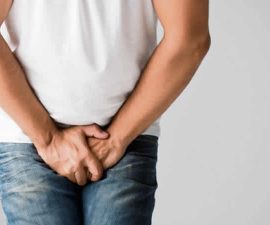The most common symptom of inguinal hernia is a bulge (swelling) in the groin or scrotum. Typically, it feels like a round lump. The bulge may arise over a period of weeks or months. But in early stages of the disease, there may be no bulge appears. In such case, are there any other specific symptoms of the condition?
The bulge of inguinal hernias appears when something (part of intestine for example) protrudes through a weak spot /a hole in the inguinal canal (a short passage through the inferior section of the abdominal cavity close to the groin).
Again, the bulge usually forms gradually. But in some cases, it may appear suddenly – for examples; after picking up heavy objects, laughing a lot, straining, coughing, or bending. In general, your risk of developing the condition increases with the following risk factors:
- Being older. Abdominal wall fascia is more likely to weaken with age.
- Inguinal hernia is about eight times higher among men. It also affects women, but rare.
- If you have a family history of the same condition – for examples a close relative (like your parent) who has the condition.
- Being white.
- Having chronic conditions that often cause excess pressure in your abdominal cavity, such as; chronic constipation (frequent straining during bowel movements) and chronic coughing.
- If you have a personal history of hernia-surgical repair or previous inguinal hernia.
- Some experts say that low birth weight (premature birth) might also increase the risk.
Sometimes the disease can be asymptomatic, which is, it doesn’t cause pain or other discomforts. Even if a lump appears, it could be painless. Other times it is painful, causing aching or burning sensation at the bulge.
Though a lump in the groin is the main symptom, the disease can also cause a number of other symptoms which can vary from person to person. These include:
- Discomforts (like pain, weakness, or pressure) in the groin. These symptoms may settle down when you lie down.
- A feeling of heaviness in the groin, particularly when lifting, coughing, straining, or bending over.
- Pain around the testicles. This can occur if the protruding abdominal tissues descend into the scrotum.
- Nausea and vomiting.
In general, inguinal hernias without bulge usually don’t cause any other symptoms. Most symptoms mentioned above often occur with a bulge. However it’s also possible to have some of those symptoms even though if the bulge doesn’t appear yet. But any symptoms without an obvious lump of hernia are vogue (inconclusive) since they could be caused by something else!
In time, inguinal hernias eventually will cause an obvious swelling or bulge in the groin. This is especially true for men.
On the other hand, hernias (including inguinal hernias) are not common in women. But when they have the condition, this could be more painful. Furthermore, the problem could also be more difficult to diagnose since it often causes no bulge in women. For a better understanding of hernias without lump, see here!
If your symptoms are inconclusive, you and your doctor usually need to perform several tests to get correct diagnosis. Some of the common ones are imaging tests such as abdominal ultrasound test, MRI, or CT-scan. But for experienced hernia specialists, a physical exam is enough to diagnose the condition in most cases – especially if you have a bulge in the groin or other areas of the abdomen where other types of hernia commonly occur.
Though early surgical-hernia repair is not always necessary, it’s worth a try to early identify your hernia so you can prepare yourself better to cope with the symptoms and prevent the condition from worsening. Most types of hernia, including inguinal hernias, are not necessarily life-threatening. But they can also turn into serious, causing dangerous complications such as strangulation and sepsis (blood poisoning). See also what NOT to do with hernias!




